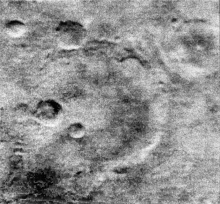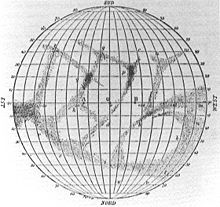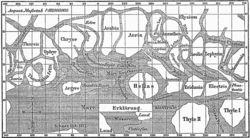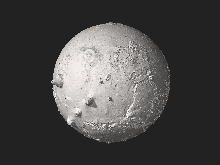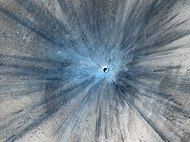Percival Lowell
| |
|---|---|

Percival Lowell during the early-20th century
| |
| Born | March 13, 1855
Boston, Massachusetts, U.S.
|
| Died | November 12, 1916 (aged 61)
Flagstaff, Arizona, U.S.
|
| Nationality | American |
| Education | Noble and Greenough School |
| Alma mater | Harvard University |
| Known for | Martian canals, Asteroids discovered: 793 Arizona (April 9, 1907) |
| Scientific career | |
| Fields | Astronomy |
Percival Lawrence Lowell (/ˈloʊəl/; March 13, 1855 – November 12, 1916) was an American businessman, author, mathematician, and astronomer who fueled speculation that there were canals on Mars. He founded the Lowell Observatory in Flagstaff, Arizona and formed the beginning of the effort that led to the discovery of Pluto 14 years after his death.
Biography
Percival Lowell c. 1904
Percival Lowell was born on March 13, 1855, in Boston, Massachusetts, the first son of Augustus Lowell and Katherine Bigelow Lowell. A member of the Brahmin Lowell family, his siblings included the poet Amy Lowell, the educator and legal scholar Abbott Lawrence Lowell, and Elizabeth Lowell Putnam, an early activist for prenatal care. They were the great-grandchildren of John Lowell and, on their mother's side, the grandchildren of Abbott Lawrence.
Percival graduated from the Noble and Greenough School in 1872 and Harvard University in 1876 with distinction in mathematics. At his college graduation, he gave a speech, considered very advanced for its time, on the nebular hypothesis. He was later awarded honorary degrees from Amherst College and Clark University. After graduation he ran a cotton mill for six years.
In the 1880s, Lowell traveled extensively in the Far East. In
August 1883, he served as a foreign secretary and counselor for a
special Korean diplomatic mission to the United States. He lived in Korea for about two months.
He also spent significant periods of time in Japan, writing books on
Japanese religion, psychology, and behavior. His texts are filled with
observations and academic discussions of various aspects of Japanese
life, including language, religious practices, economics, travel in
Japan, and the development of personality.
Books by Percival Lowell on the Orient include Noto: An Unexplored Corner of Japan (1891) and Occult Japan, or the Way of the Gods (1894), the latter from his third and final trip to the region. His time in Korea inspired Chosön: The Land of the Morning Calm (1886, Boston). The most popular of Lowell's books on the Orient, The Soul of the Far East
(1888), contains an early synthesis of some of his ideas, that in
essence, postulated that human progress is a function of the qualities
of individuality and imagination. The writer Lafcadio Hearn called it a "colossal, splendid, godlike book." At his death he left with his assistant Wrexie Leonard an unpublished manuscript of a book entitled Peaks and Plateaux in the Effect on Tree Life.
Lowell was elected a Fellow of the American Academy of Arts and Sciences in 1892. He moved back to the United States in 1893. He became determined to study Mars and astronomy as a full-time career after reading Camille Flammarion's La planète Mars. He was particularly interested in the canals of Mars, as drawn by Italian astronomer Giovanni Schiaparelli,
who was director of the Milan Observatory. Beginning in the winter of
1893–94, using his wealth and influence, Lowell dedicated himself to the
study of astronomy, founding the observatory which bears his name. He chose Flagstaff, Arizona Territory,
as the home of his new observatory. At an altitude of over 2,100 meters
(6,900 feet), with few cloudy nights, and far from city lights,
Flagstaff was an excellent site for astronomical observations. This
marked the first time an observatory had been deliberately located in a
remote, elevated place for optimal seeing.
In 1904, Lowell received the Prix Jules Janssen, the highest award of the Société astronomique de France,
the French astronomical society. For the last 23 years of his life,
astronomy, Lowell Observatory, and his and others' work at his
observatory were the focal points of his life.
World War I
very much saddened Lowell, a dedicated pacifist. This, along with some
setbacks in his astronomical work (described below), undermined his
health and contributed to his death from a stroke on November 12, 1916,
aged 61.
Lowell is buried on Mars Hill near his observatory. Lowell claimed to
"stick to the church" though at least one current author describes him
as an agnostic.
Canals of Mars
Martian canals depicted by Percival Lowell.
For the next fifteen years he studied Mars extensively, and made
intricate drawings of the surface markings as he perceived them. Lowell
published his views in three books: Mars (1895), Mars and Its Canals (1906), and Mars As the Abode of Life
(1908). With these writings, Lowell more than anyone else popularized
the long-held belief that these markings showed that Mars sustained
intelligent life forms.
His works include a detailed description of what he termed the
'non-natural features' of the planet's surface, including especially a
full account of the 'canals,' single and double; the 'oases,' as he
termed the dark spots at their intersections; and the varying visibility
of both, depending partly on the Martian seasons. He theorized that an
advanced but desperate culture had built the canals to tap Mars' polar
ice caps, the last source of water on an inexorably drying planet.
Craters on the Mars surface (frame 11) imaged by Mariner 4 as it flew by Mars in 1965
While this idea excited the public, the astronomical community was
skeptical. Many astronomers could not see these markings, and few
believed that they were as extensive as Lowell claimed. As a result,
Lowell and his observatory were largely ostracized. Although the consensus was that some actual features did exist which would account for these markings, in 1909 the sixty-inch Mount Wilson Observatory
telescope in Southern California allowed closer observation of the
structures Lowell had interpreted as canals, and revealed irregular
geological features, probably the result of natural erosion.
The existence of canal-like features was definitively disproved in the 1960s by NASA's Mariner missions. Mariner 4, 6, and 7, and the Mariner 9
orbiter (1972), did not capture images of canals but instead showed a
cratered Martian surface. Today, the surface markings taken to be canals
are regarded as an optical illusion.
Psychologist Matthew J. Sharps has argued that perception of the canals
by Lowell and others could have been the result of a combination of
psychological factors, including individual differences, Gestalt reconfiguration, and sociocognitive factors.
Venus spokes
Percival
Lowell in 1914, observing Venus in the daytime with the 24-inch (61 cm)
Alvan Clark & Sons refracting telescope at Flagstaff, Arizona
Although Lowell was better known for his observations of Mars, he also drew maps of the planet Venus. He began observing Venus in detail in mid-1896 soon after the 61-centimetre (24-inch) Alvan Clark & Sons
refracting telescope was installed at his new Flagstaff, Arizona
observatory. Lowell observed the planet high in the daytime sky with the
telescope's lens stopped down to 3 inches in diameter to reduce the
effect of the turbulent daytime atmosphere. Lowell observed spoke-like
surface features including a central dark spot, contrary to what was
suspected then (and known now): that Venus has no surface features
visible from Earth, being covered in an atmosphere that is opaque. It
has been noted in a 2003 Journal for the History of Astronomy paper and in an article published in Sky and Telescope in July 2003 that Lowell's stopping down of the telescope created such a small exit pupil at the eyepiece, it may have become a giant ophthalmoscope giving Lowell an image of the shadows of blood vessels cast on the retina of his own eye.
Pluto
Lowell's greatest contribution to planetary studies came during the last decade of his life, which he devoted to the search for Planet X, a hypothetical planet beyond Neptune. Lowell believed that the planets Uranus and Neptune were displaced from their predicted positions by the gravity of the unseen Planet X. Lowell started a search program in 1906 using a camera 5 inches (13 cm) in aperture. The small field of view of the 42-inch (110 cm) reflecting telescope rendered the instrument impractical for searching. From 1914 to 1916, a 9-inch (23 cm) telescope on loan from Sproul Observatory was used to search for Planet X. Lowell did not discover Pluto but later Lowell Observatory (observatory code 690) would photograph Pluto in March and April 1915, without realizing at the time that it was not a star.
In 1930 Clyde Tombaugh, working at the Lowell Observatory, discovered Pluto near the location expected for Planet X. Partly in recognition of Lowell's efforts, a stylized P-L monogram ( ) – the first two letters of the new planet's name and also Lowell's initials – was chosen as Pluto's astronomical symbol. However, it would subsequently emerge that the Planet X theory was mistaken.
) – the first two letters of the new planet's name and also Lowell's initials – was chosen as Pluto's astronomical symbol. However, it would subsequently emerge that the Planet X theory was mistaken.
Pluto's mass could not be determined until 1978, when its
satellite Charon was discovered. This confirmed what had been
increasingly suspected: Pluto's gravitational influence on Uranus and
Neptune is negligible, certainly not nearly enough to account for the
discrepancies in their orbits. In 2006, Pluto was reclassified as a dwarf planet by the International Astronomical Union.
In addition, it is now known that the discrepancies between the predicted and observed positions of Uranus and Neptune were not caused by the gravity of an unknown planet. Rather, they were due to an erroneous value for the mass of Neptune. Voyager 2's 1989 encounter with Neptune yielded a more precise value of its mass, and the discrepancies disappear when using this value.
Legacy
Lowell mausoleum in 2013
Although Lowell's theories of the Martian canals, of surface features
on Venus, and of Planet X are now discredited, his practice of building
observatories at the position where they would best function has been
adopted as a principle. He also established the program and setting which made the discovery of Pluto by Clyde Tombaugh possible. Lowell has been described by other planetary scientists as "the most influential popularizer of planetary science in America before Carl Sagan".
While eventually disproved, Lowell's vision of the Martian
canals, as an artifact of an ancient civilization making a desperate
last effort to survive, significantly influences the development of science fiction – starting with H. G. Wells' influential The War of the Worlds, which made the further logical inference that creatures from a dying planet might seek to invade Earth.
The image of the dying Mars and its ancient culture was retained,
in numerous versions and variations, in most science fiction works
depicting Mars in the first half of the twentieth century (see Mars in fiction).
Even when proven to be factually mistaken, the vision of Mars derived
from his theories remains enshrined in works that remain in print and
widely read as classics of science fiction.
Lowell's influence on science fiction remains strong. The canals figure prominently in Red Planet by Robert A. Heinlein (1949) and The Martian Chronicles by Ray Bradbury (1950). The canals, and even Lowell's mausoleum, heavily influence The Gods of Mars (1918) by Edgar Rice Burroughs as well as all other books in the Barsoom series.
Asteroid 1886 Lowell, discovered by Henry Giclas and Robert Schaldach in 1949, as well as crater Lowell on the Moon, and crater Lowell on Mars, were named after him. The Lowell Regio on Pluto was also named in his honor after its discovery by the New Horizons spacecraft in 2015.
Publications
- The Soul of the Far East (1888)
- Noto: An Unexplored Corner of Japan (1891)
- Occult Japan, or the Way of the Gods (1894)
- Collected Writings on Japan and Asia, including Letters to Amy Lowell and Lafcadio Hearn, 5 vols., Tokyo: Edition Synapse. ISBN 978-4-901481-48-9 www.aplink.co.jp/synapse/4-901481-48-7.htm
- Chosön: The Land of the Morning Calm ; a Sketch of Korea. Ticknor. 1886.
- Mars (1895)
- Mars and Its Canals (1906)
- Mars As the Abode of Life (1908)
- The Evolution of Worlds (1910) (Full text at
 The Evolution of Worlds.)
The Evolution of Worlds.)


